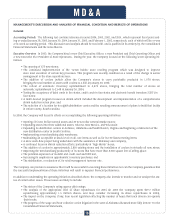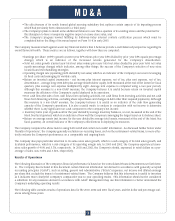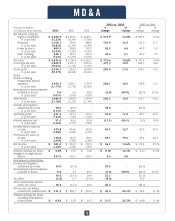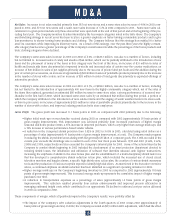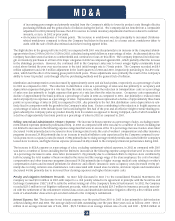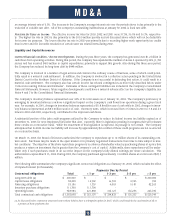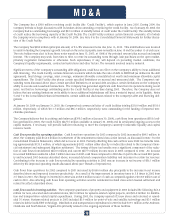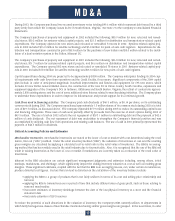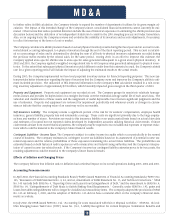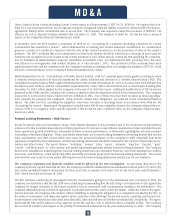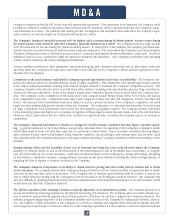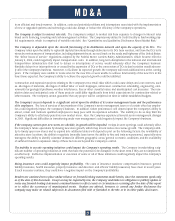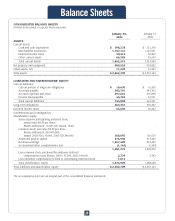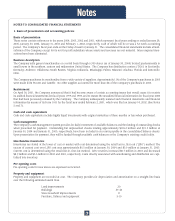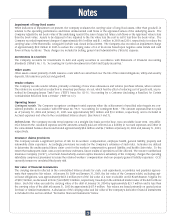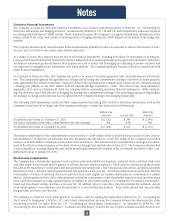Dollar General 2003 Annual Report Download - page 22
Download and view the complete annual report
Please find page 22 of the 2003 Dollar General annual report below. You can navigate through the pages in the report by either clicking on the pages listed below, or by using the keyword search tool below to find specific information within the annual report.
can give no assurances that the SEC or the court will approve this agreement. If the agreement is not approved, the Company could
be subject to different or additional penalties, both monetary and non-monetary, which could adversely affect the Company’s finan-
cial statements as a whole. The publicity surrounding the SEC investigation and settlement also could affect the Company’s repu-
tation and have an adverse impact on its financial statements as a whole.
The Company’s business is modestly seasonal with the highest sales occurring during the fourth quarter. Adverse events during
the fourth quarter could, therefore, affect the Company’s financial statements as a whole. The Company realizes a larger portion
of its net sales and net income during the Christmas selling season. In anticipation of the holidays, the Company purchases sub-
stantial amounts of seasonal inventory and hires many temporary employees. If for any reason the Company’s net sales during the
Christmas selling season were to fall below seasonal norms, a seasonal merchandise inventory imbalance could result. If such an
imbalance were to occur, markdowns might be required to minimize this imbalance. The Company’s profitability and operating
results could be adversely affected by unbudgeted markdowns.
Adverse weather conditions or other disruptions, especially during the peak Christmas season but also at other times, could also
adversely affect the Company’s net sales and could make it more difficult for the Company to obtain sufficient quantities of mer-
chandise from its suppliers.
Competition in the retail industry could limit the Company’s growth opportunities and reduce its profitability. The Company com-
petes in the discount retail merchandise business, which is highly competitive. This competitive environment subjects the Company
to the risk of reduced profitability resulting from reduced margins required to maintain the Company’s competitive position. The
Company competes with discount stores and with many other retailers, including mass merchandise, grocery, drug, convenience,
variety and other specialty stores. Some of the nation’s largest retail companies operate stores in areas where the Company oper-
ates. The Company’s direct competitors in the dollar store retail category include Family Dollar, Dollar Tree, Fred’s, and various
local, independent operators. Competitors from other retail categories include CVS, Rite Aid, Walgreens, Eckerd, Wal-Mart and
Kmart. The discount retail merchandise business is subject to excess capacity and some of the Company’s competitors are much
larger and have substantially greater resources than the Company. The competition for customers has intensified in recent years
as larger competitors, such as Wal-Mart, have moved into the Company’s geographic markets. The Company remains vulnerable
to the marketing power and high level of consumer recognition of these major national discount chains, and to the risk that these
chains or others could venture into the "dollar store" industry in a significant way. Generally, the Company expects an increase in
competition.
The Company’s financial performance is sensitive to changes in overall economic conditions that may impact consumer spend-
ing. A general slowdown in the United States economy may adversely affect the spending of the Company’s consumers, which
would likely result in lower net sales than expected on a quarterly or annual basis. Future economic conditions affecting dispos-
able consumer income, such as employment levels, business conditions, fuel and energy costs, interest rates, and tax rates, could
also adversely affect the Company’s business by reducing consumer spending or causing consumers to shift their spending to other
products.
Existing military efforts and the possibility of war, acts of terrorism and rising fuel costs could adversely impact the Company.
Existing U.S. military efforts, as well as the involvement of the United States in a war in the Middle East or elsewhere, or a signifi-
cant act of terrorism on U.S. soil or elsewhere, could have an adverse impact on the Company by, among other things, disrupting
its information or distribution systems, causing dramatic increases in fuel prices thereby increasing the costs of doing business, or
impeding the flow of imports or domestic products to the Company.
The Company’s business is dependent on its ability to obtain attractive pricing and other terms from its vendors and to timely
receive inventory. The Company believes that it has generally good relations with its vendors and that it is generally able to obtain
attractive pricing and other terms from vendors. If the Company fails to maintain good relations with its vendors, it may not be
able to obtain attractive pricing with the consequence that its net sales or profit margins would be reduced. The Company may
also face difficulty in obtaining needed inventory from its vendors because of interruptions in production or for other reasons, which
would adversely affect the Company’s business.
The efficient operation of the Company’s business is heavily dependent on its information systems. The Company depends on a
variety of information technology systems for the efficient functioning of its business. The Company relies on certain software ven-
dors to maintain and periodically upgrade many of these systems so that they can continue to support the Company’s business. The
software programs supporting many of the Company’s systems were licensed to the Company by independent software develop-
ers. The inability of these developers or the Company to continue to maintain and upgrade these information systems and soft-
ware programs would disrupt or reduce the efficiency of the Company’s operations if it were unable to convert to alternate systems
M D & A
20


